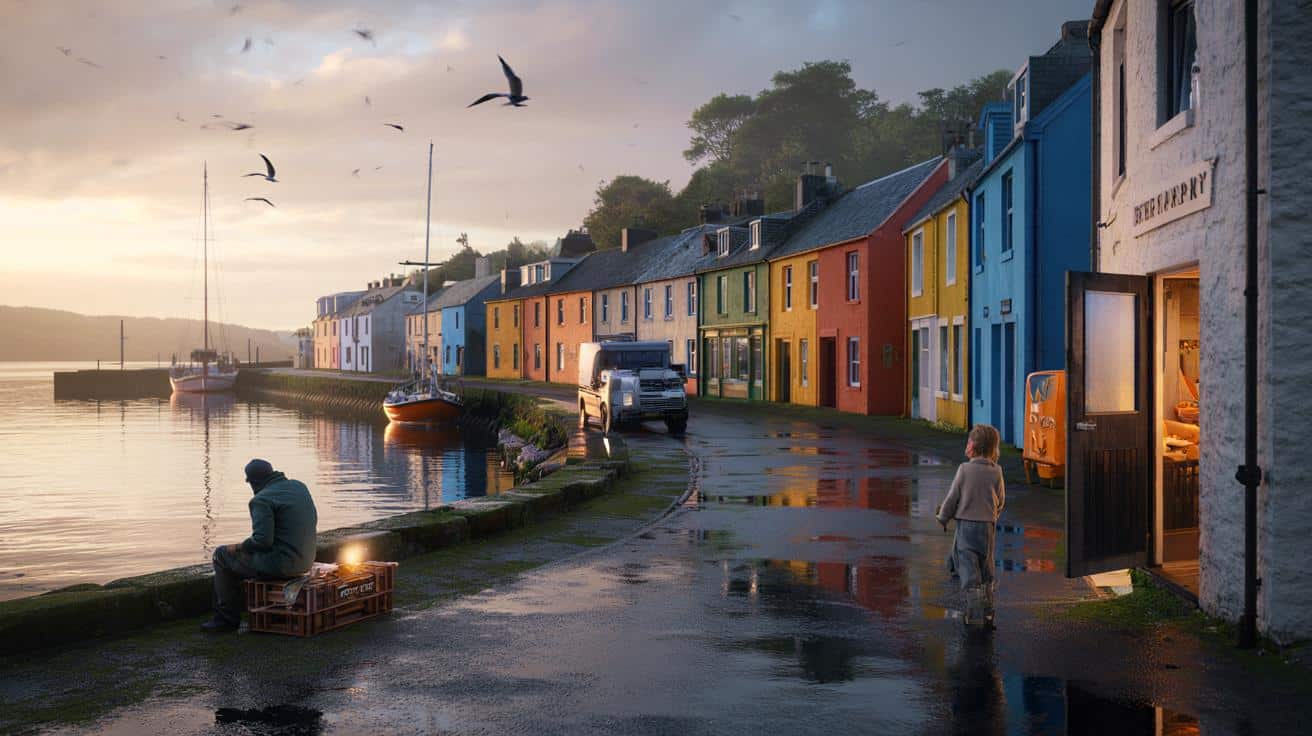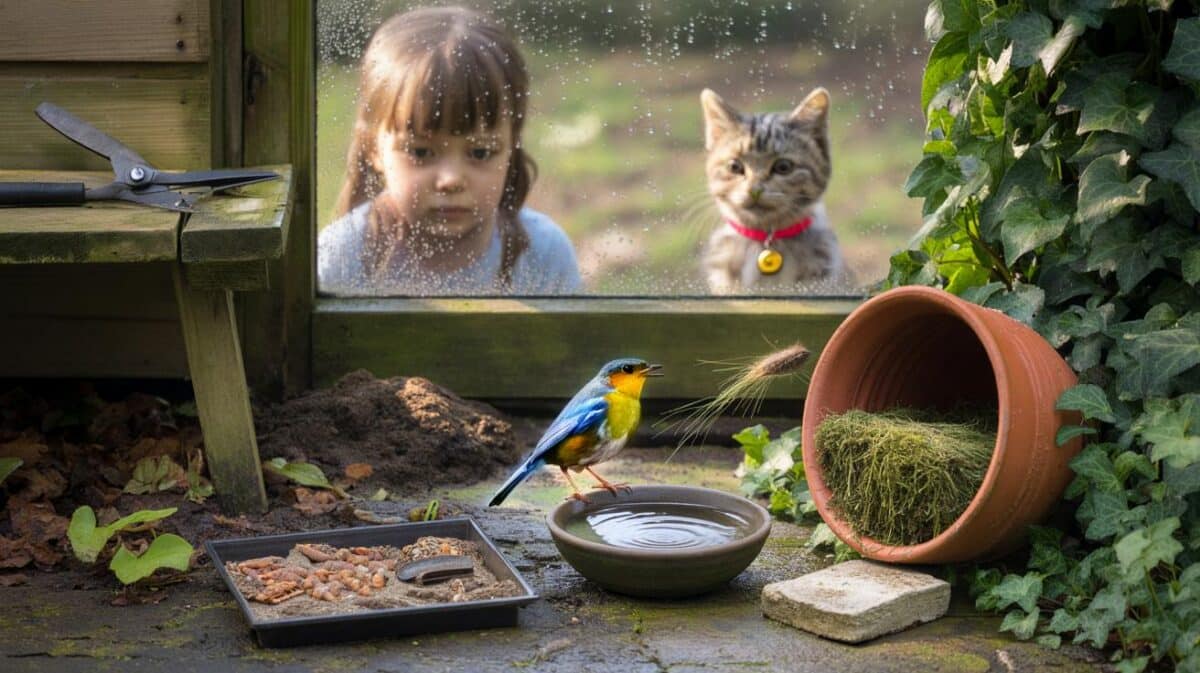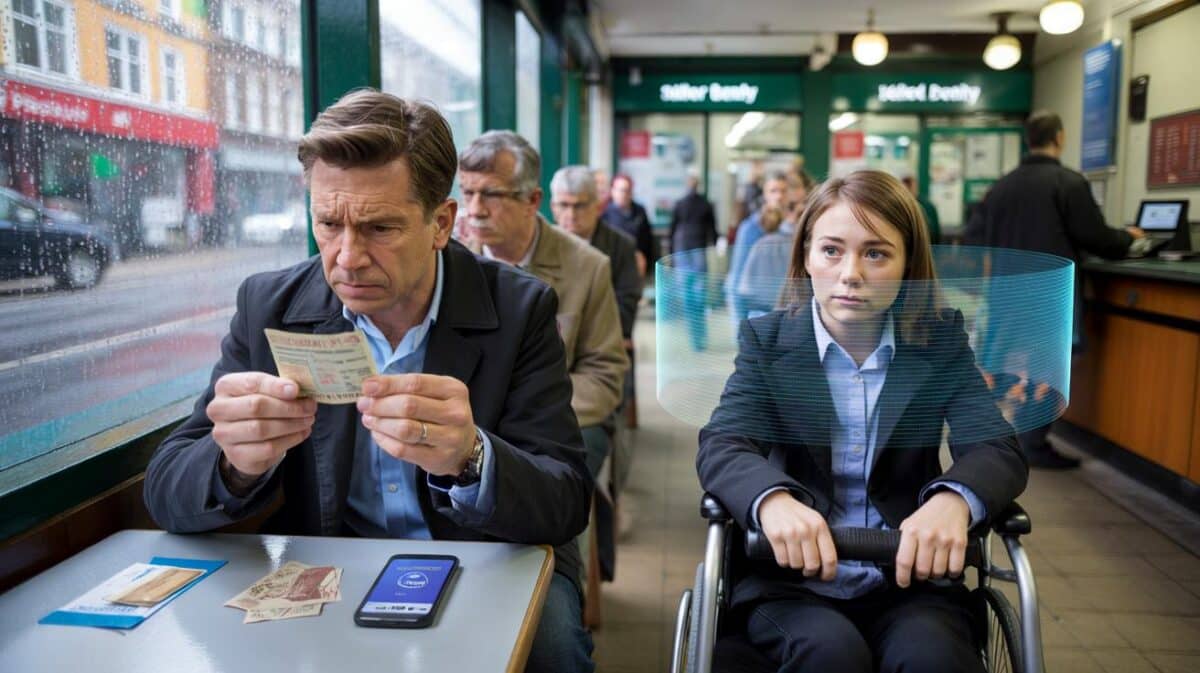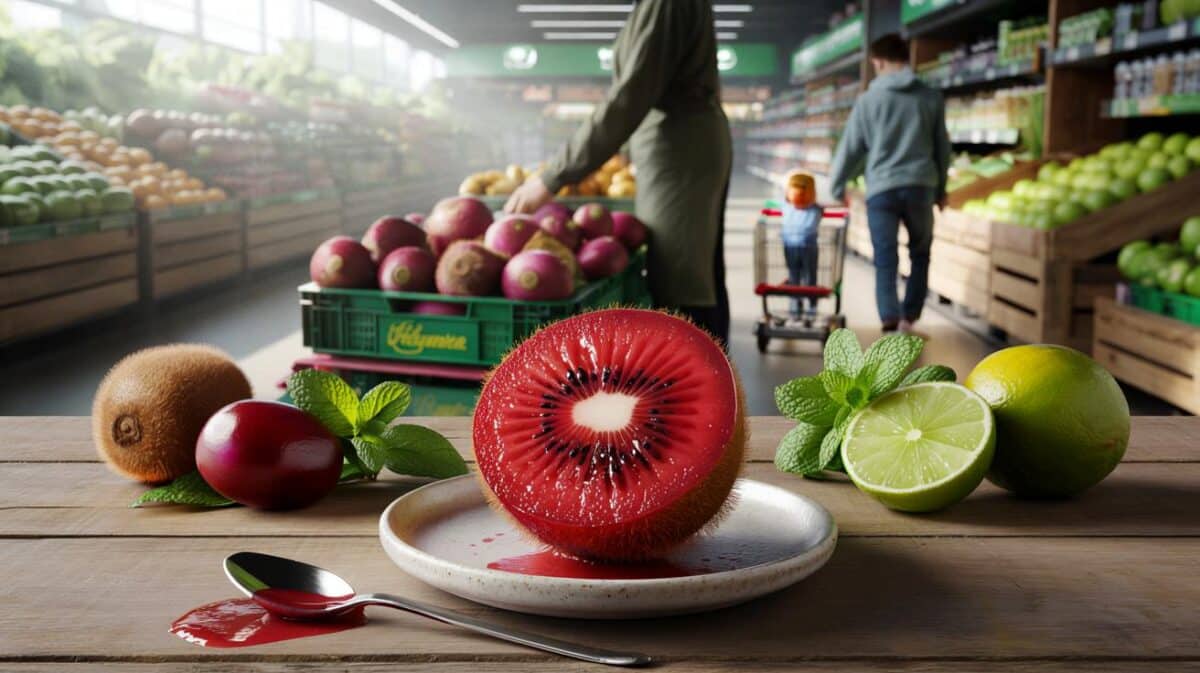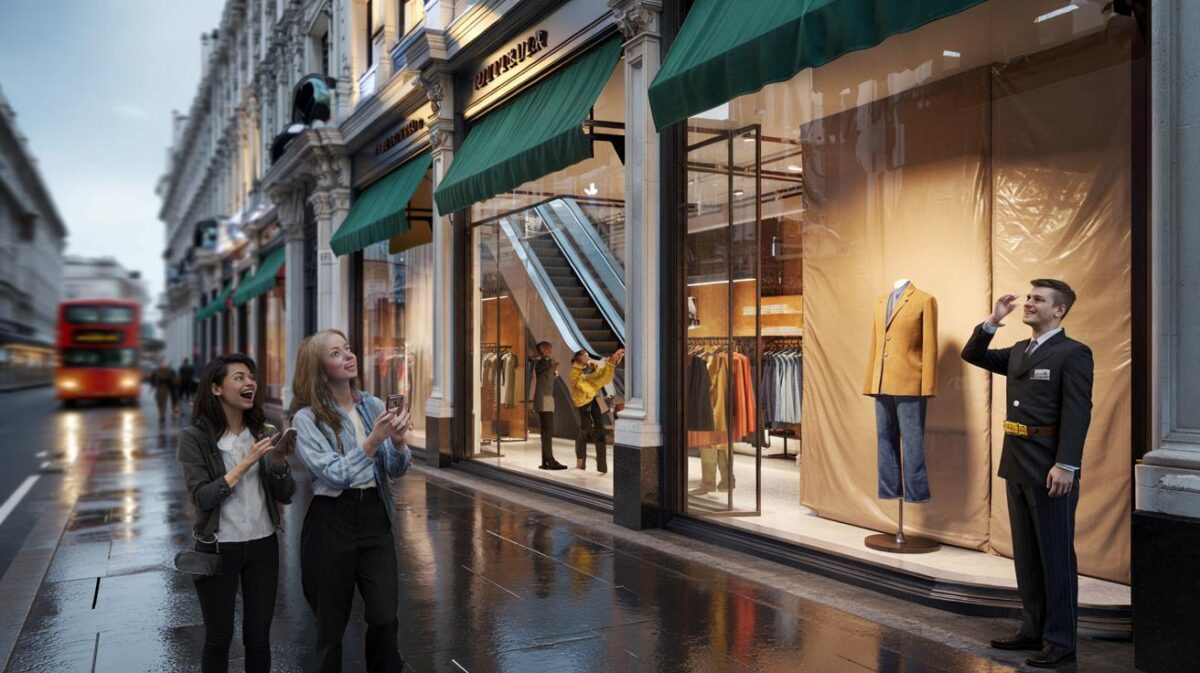A pretty claim has been doing the rounds among Scottish travellers: that the most beautiful main street in the country isn’t in a city at all, but in a little harbour town where the shopfronts glow like a paintbox after rain.
A milky light slides into Tobermory Bay, and the row of houses along Main Street—lemon, coral, midnight blue—seems to wake like a chorus warming up. Gulls float over the masts, a baker nudges open the door, and the scent of warm rolls jostles with seaweed and salt.
A lorry inches past the harbour wall, tyres hissing on wet tarmac. A child tugs at a sleeve, pointing at the pink one, the blue one. A fisherman takes his first coffee on an upturned crate, gazing at the colours sliding into the water, as if he’s seeing them for the first time too.
People say it’s the best-looking main street in Scotland. The street has opinions of its own.
Tobermory’s paintbox by the sea
Walk the curve from the distillery to the pier and there’s a rhythm you feel in your feet. The buildings huddle close, their paintwork glossed by Atlantic air, their windowpanes squinting at the tide. You catch yourself slowing down, as if the palette demands it.
The trick is the harbour. Water makes a mirror, and the mirror plays magician. A mustard gable becomes liquid gold; a sky-blue shopfront turns electric in the ripples. *Yes, those colours are real.*
Then comes the breeze, lifting flags and fish smells and chatter from doorways where locals trade gossip. The street is only a few hundred metres. It never shouts. It hums—and somehow that’s bigger.
If you’ve seen the children’s TV show Balamory, you’ve met this curve in a different costume. The programme’s cheery palette took its lead from here, exaggerating what the town already knew: that colour changes how a place feels in your chest. Parents still arrive with small kids who gasp as if a set has come to life, only to discover it’s just a working street, with a co-op, a chippy, and a post office that closes for lunch.
I watched a decorator at a window near the ferry office, brush moving with the patience of someone who belongs. He didn’t glance up when a coach emptied onto the pavement. Paint, dry, repeat—his rhythm made the day ordinary again. That’s the magic. This isn’t a parade float; it’s a place where bins go out and deliveries run late.
Beauty feels different when it’s lived-in. The distillery breathes peat at one end, the lifeboat sits ready at the other, and between them the street works. **Maybe that’s why people keep calling it the most beautiful: because it’s useful, not curated.** You can buy screws and scallops, postcards and waterproofs, all while the tide makes its slow arguments with the moon.
Even on a drizzly Tuesday, you get an arrangement that photographers would pay rent for. The bay arcs, the buildings step back just enough, the hill behind throws a soft backdrop, and the harbour stage-lights the whole lot. If you’re a composition nerd, this is geometry doing a friendly wink: leading line, repetition, negative space, a colour wheel that’s more pub conversation than textbook.
Stand by the war memorial and you see how the elevation cheats the eye. From here the line of houses looks almost like a theatre set, flat and vivid, while down at pavement level it folds around you like a jacket. One view says postcard; the other says home.
And then there’s the sound. Lines get written about colour, but listen: rigging ticking. A kettle pouring. A dog’s collar chiming against a café chair. Streets that are pretty are one thing. Streets that make you listen are rarer—and they tend to stick.
How to see it at its best
Start early. Step off the bus or park at Ledaig car park, face the water, then turn slowly until the colours line up. Walk towards the distillery first, so the light comes over your shoulder, then double back along the harbour wall for the reflections. When the tide is high and the surface calm, the street paints itself twice.
Give yourself permission to loiter. Ten minutes at the pier, five at the bench by the RNLI station, two more outside the sweet shop. Try the lighthouse path to Rubha nan Gall for the long view, or climb towards the golf course for a peek that tucks the street into the hills. **Let’s be honest: no one actually does that every day.** That’s exactly why it feels like a small victory when you do.
We’ve all had that moment where a pretty place slips away because we sprinted through it. Don’t sprint. If the weather turns, duck into the Mull Museum for a spell, then come back out when the light goes pearly. On showery days the colours pop like sweets; in blue-sky weather they read as calm. Sunset throws a rose glaze across the bay, but the blue hour is the hush you’ll remember.
Common mistakes? Treating Main Street as a single selfie stop. The joy is in parts: the chipped doorstep, the chalkboard with an accidental haiku, the wet rope coiled in expert loops. Another mistake is ignoring lunch. Get fish and chips from the van or a bowl of Cullen skink, then find a wall and eat it with your feet dangling. The view makes napkins optional.
Transport nerves are normal. The ferry from Oban to Craignure is easygoing on calm days, and buses run up to Tobermory. If you’re driving, the island prefers patience to speed; single-track etiquette is a kind of neighbourliness in motion. Rain happens. Wind happens. The colours won’t flinch.
Local voices will tell you the street is not a museum, and you feel that in the way the bins move and the crates appear. The trick is to blend in, wave at drivers who pause at passing places, and keep the camera down sometimes.
Stand still, and the street begins to move around you. That’s when you realise it isn’t the paint you came for. It’s the pace.
- Getting there: Oban–Craignure ferry, then bus 495 to Tobermory (or drive carefully on single-track roads).
- Best light: early morning for calm water; blue hour for mood; passing showers for saturated colour.
- Food: fish and chips by the harbour, bakery rolls in the morning, a dram from Tobermory Distillery later.
- Plan B: Mull Museum, a sit-down with a view, or a lighthouse walk when the rain eases.
- Practical: parking at Ledaig; keep coins handy; watch for delivery vans on the narrow bends.
What this street says about Scotland now
It’s tempting to call Tobermory a lovely accident. It isn’t. The colours are a choice. The working harbour is a choice. Shops that stock both postcards and plumbing supplies are a choice. In a time when many high streets are hollowing out, this little main street still goes to work each day, carrying tourists and weekly shops and rainy-day rituals on the same small shoulders.
There’s a thread of care running through the paint tins and the tide tables. You can feel it in the way the window boxes keep trying, even on a squally morning, and in the way a teenager holds the door so someone with a pram can wrangle past. **Beauty sticks in places where people keep showing up for the unglamorous bits.** That’s not a travel slogan. That’s a community habit.
Maybe that’s why the street whispers to people who arrive with nothing but a free afternoon. You don’t need a monument here; the curve is the monument. Stand with your back to the bay and let the colours do their quiet work on your mood. There’s no moral to it. Just a small, steady reminder that ordinary can be gorgeous when people decide it will be.
| Key point | Detail | Interest for readers |
|---|---|---|
| Where | Tobermory, Isle of Mull—harbour-hugging Main Street | Pinpoint the setting everyone talks about |
| Why it stuns | Colour, curve, water reflections, daily life in motion | Understand what makes photos and memories sing |
| How to see it | Early light, slow walk, lighthouse and hill viewpoints | Practical, repeatable way to catch the best moments |
FAQ :
- Is Tobermory really Scotland’s most beautiful main street?It’s a strong contender. The mix of colour, harbour reflections, and daily bustle gives it a hold few streets manage.
- How do I get there without a car?Ferry from Oban to Craignure, then bus 495 to Tobermory. Services are regular in season and perfectly doable for a day trip.
- When’s the best time to visit?Spring and early autumn bring softer light and fewer crowds. Summer is lively, winter can be bracing and blue-hour beautiful.
- Where are the best viewpoints?The pier for reflections, the war memorial for a gentle elevation, the path to Rubha nan Gall for the long look back.
- What else should I do nearby?Tour Tobermory Distillery, pop into the Mull Museum, wander the lighthouse path, and browse for local crafts along the harbour.

